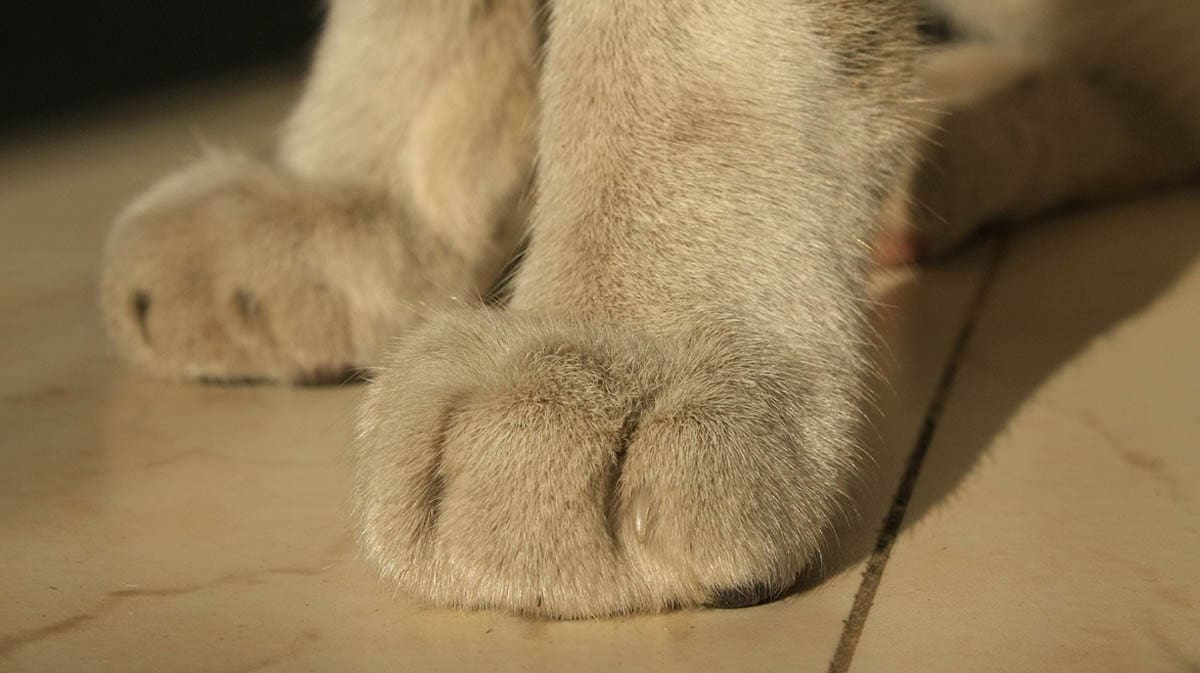Limping is a common symptom and can affect the front or the hind limbs. It can be acute (sudden onset) or chronic (slow and progressive). The location, accompanying symptoms and age of the cat can all give the veterinarian a clue as to the probable cause.
Causes of limping in cats
Osteoarthritis
Osteoarthritis is a condition characterised by the breakdown of the joints and surrounding tissues. It is under-diagnosed in cats who often put stiffness down to normal aging. 60% of cats over 6 and 90% of cats over 12 show signs of arthritis.
Affected limbs:
Forelimb and hind limb
Cancer
Cancer is the uncontrolled growth of cells within the body and can affect any body system or cell line. The most common cause of cancer affecting the limbs is osteosarcoma or bone cancer.
Affected limbs:
Forelimb and hindlimb
Injuries
The legs and feet are at increased risk of injury which can occur if the cat lands badly, falls from a height, a deliberate trauma (kicked or hit) or is involved in a motor vehicle accident. Injuries can include:
- Broken bones
- Joint dislocation
- Sprains
- Torn ligaments
- Paw pad injuries such as cuts, abrasions and foreign bodies (thorns, glass, splinters)
- Torn claws
- Frostbite
- Burns (hot tarmac, jumping on stoves)
- Spinal injury or trauma
- Back injury
- Cuts and lacerations
- Declawing pain
Affected limbs:
Forelimb and hind limb
Abscess
An abscess is a walled-off collection of puss which is most commonly caused by a bite from another cat that introduces bacteria under the skin. The body attempts to contain the infection by walling off the area.
Affected limbs:
Forelimb and hind limb
Cruciate ligament rupture
The cruciate ligaments are two fibrous bands that form an X shape in the knee; a rupture is a tear in one or both of the ligaments due to trauma, such as a sudden movement that twists the knee leading to hind-limb lameness.
Affected limbs:
Hind limbs
Hip dysplasia
An abnormality of the hip joint in which the hip socket doesn’t fully cover the ball at the end of the femur (thigh bone). Joint looseness (laxity) can lead to degenerative joint disease.
Affected limbs:
Hind limbs
Patellar luxation
A condition in which the kneecap (patellar) moves (or dislocates) out of the trochlear groove, and moves to the inside (medial) or outside (lateral) of the knee joint (known as the stifle joint in cats).
Affected limbs:
Hind limbs
Bone infection
Osteomyelitis is either inflammation or infection of the bone. Bacteria are the most common pathogen, although systemic fungal infections can also spread to the bones.
Affected limbs:
Forelimb, hind limb
Panosteitis
A painful inflammatory condition that affects one or more long bones of the cat’s legs. It occurs in young cats.
Affected limbs:
Forelimb, hind limb
Plasma cell pododermatitis
An inflammatory disease that affects the footpads of cats.
Affected limbs:
Forelimb and hind limb
Overgrown claws
As cats age, their claws can become thickened, brittle and overgrown, and eventually curl in on themselves, cutting into the paw pad. The claws on the front feet are most commonly affected.
Affected limbs:
Forelimb
Systemic disease
An underlying disease that can affect different body systems or the body as a whole. Common causes include:
- Calicivirus or Lyme disease (which causes a form of transient arthritis)
- Hemophilia a bleeding disorder in which the blood doesn’t clot properly, it is the most well-known of the bleeding disorders to affect cats.
- Pemphigus a group of rare skin disorders that cause blisters and sores on the skin or mucous membranes due to an overactive immune response.
Affected limbs:
Forelimb and hind limb
Symptoms
The most apparent clinical sign is lameness, additional symptoms may be present depending on the underlying cause.
- Lameness which can affect one or multiple limbs
- Reluctance to bear weight on the affected limb
- Stiffness, especially upon waking
- Grooming less due to lack of mobility or pain
- Pain when touched
- Wounds or trauma such as scratches, cuts, swelling
- A hot, painful lump if the cat has an abscess, over time the skin will thin until the abscess ruptures
- Reluctance to jump or climb
- Any abnormal lumps or bumps
- Disfigurement of the limb
- As the cat walks, he may skip or hop on the affected leg; he frequently pulls the leg up towards the body and skips
Diagnosis
Never treat a limping cat with human painkillers, which are toxic. If the cat appears otherwise well, wait and see. If after 24 hours there is no improvement, seek veterinary advice. Where an obvious injury or abnormality is present, immediate veterinary attention is necessary, otherwise.
The veterinarian will perform a complete physical examination and obtain a medical history from you. During the examination, they will carefully evaluate the limbs and feet, feeling for lumps, bumps, and abnormalities, check the cat’s range of motion and look for obvious signs of injury. Some causes, such as an abscess, claw or paw pad injury, and lacerations can be diagnosed during the examination. However, if a cause can not be determined, it will be necessary to perform tests, which may include:
- Imaging – Xrays or ultrasound to look for broken bones or tumours.
- Biopsies – A small sample of tissue is taken for evaluation to look for abnormal cells.
- Blood tests – Complete blood count and biochemical profile evaluate the overall health of the cat as well as look for signs of infection or hemophilia.
Treatment
The goal of treatment is to address the underlying cause as well as manage symptoms to reduce discomfort and avoid further damage. This may include surgery to repair abnormalities, remove foreign bodies, repair injuries or remove cancers. Cage rest or confine the cat to a small area to avoid additional trauma and medications including anti-inflammatories, corticosteroids and antibiotics.

